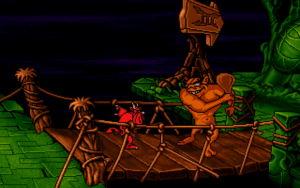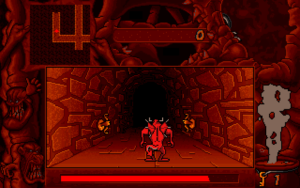Litil Divil: Some Puzzles
I finally found the save room in maze 3, and close by, a single challenge room. On the other side of the challenge lies more maze. I have not yet found any more rooms. This maze is a lot bigger than I remember them being. And on top of that, the one challenge room I found? It’s another maze. A smaller one, with different rules and different presentation: multi-tiered, isometric, and with a sort of node that you disappear into at every bend or intersection. Key to solving it is realizing that pressing the primary action button while in a node switches you to a view of the inside of the node, where items and elevator platforms are hidden. That’s the kind of puzzle you find in the rooms. There’s always a bit of guesswork before you can start solving them for real.
Some other notable puzzles I’ve seen so far:
The very first puzzle you encounter on level 1 involves a spider-demon that sits in place and spawns spiders, which follow you erratically and attack you. It doesn’t take long to figure out that the action buttons make you step on spiders, or occasionally pick them up and eat them, but it’s a losing battle: the demon just spawns more to replace any that you kill, and you can’t do anything to stop it. Until, that is, you buy some bug spray from the shop. Then the two action buttons do two different things, one stomping and one spraying.
A sort of wizard’s laboratory, with a row of colored flasks, a bubbling cauldron, and four wizards playing poker — although before long, one of them gets irritated at another and turns him into a frog. Get close enough to the flasks, and you enter a special mode where you select stuff to throw into the cauldron. The correct combination is found elsewhere in the maze. Even once I had that, it took me a while to find the place I had to stand to take a drink out of the cauldron. Drinking the correct concoction temporarily turns you into a mouse, letting you escape through a hole in the wainscotting on the opposite side of the room — but only if you can evade the cat that’s been sleeping by the poker table until that moment.
A sleeping dragon on a treasure hoard, albeit apparently not the sort of treasure you collect in the maze. There’s one item in the hoard you need, but it’s on the other side of the gouts of flame the dragon is breathing out of its nose in its sleep. You can, however, reach a heap of large gemstones, and pick them up and throw them (with no ability to alter distance or direction). I suspected early on that the solution was to throw the gems to plug the dragon’s nostrils, but it still took me multiple visits to find the exact spot you have to stand on to get them in place. And even then, you have limited time before the gems burn up.
So there’s action elements in most puzzles, just as there’s a puzzle element in most of the game’s action scenes.
 Comments(0)
Comments(0)
